| Columns Retired Columns & Blogs |
very engaging read
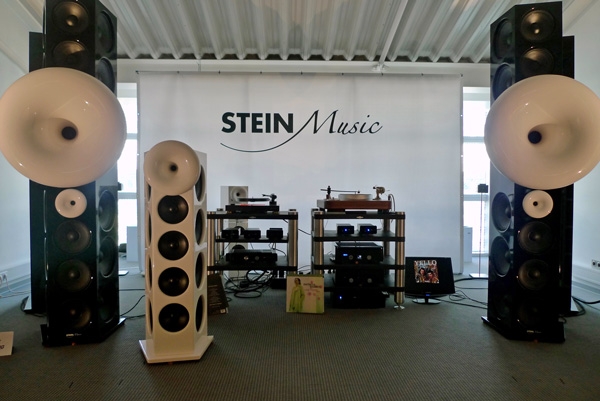
I have some cheer though because one of the best ones I definitely did not miss was Stein Music's Top Line Bob XL flagship. The Bob XL is a 90"-high, four-way hornspeaker that costs 128,000 Euros/pair . Each main Top Line speaker tower is accompanied by a separate Bob XL subwoofer tower with eight 18" DSP-controlled active woofers with an amplifier output of 3000W and a cost of 44,000 Euros each. The subwoofers reach down to 17Hz, with a crossover at 60Hz. The Top Line Bob's slender main tower features spherical mid and upper-mid horns plus a bevy of 18 (!) upper-bass/lower-midrange drivers. Folks, you have to sit way back (no less than three-meters) because there will be a lot of air moving in front of you.
When I sat down, Stein Music's Holger Stein asked me what I wanted to hear. I felt like answering, "I am hungry, tired, and cranky—I need a snack and some caffeine." Instead I smiled, "Play whatever you like . . . make your best demonstration." Holger proceeded to play Yello's classic 1991 album Baby. It sounded sweet super tactile, and giantly expansive. The choice seemed perfectly fitting: Dieter Meier, Boris Blank, Holger Stein, and Herbert Reichert . . . "Oh Yeah!"
I was not surprised by Holger's choice, because, at shows people try to play the music that showcases their system's strengths. Consequently, people with hornspeakers like to play techno/electronica/drum and bass. Why? Mainly, because nothing plays electronica bigger or better than big horns. And, because big horns can really put that all that enormous expanding synth energy out into the room—with virtually no miniaturization. Electronic music also has the effect of distracting the listener's critical mind from issues of tone character or pinpoint imaging. Good tone and focused imaging require speakers that behave properly in the realms of phase and time—something multi-horn systems often struggle with.
After Yello, I asked for some solo piano which sounded crisp, clear, and, very much like a real piano. (This system likely moved more room air than a Steinway concert grand.) Next I asked for vocals and Holger played Youn Sun Nah doing Nine Inch Nails' classic, "Hurt". After which I dozed off and began to dream. When I woke, both Holger and Gabrele Stein were asking, "Are you alright? Is there anything else we can play for you?" Whereupon I excused myself, stumbled out, and ran to the cafe for kaffee und Dänisch.
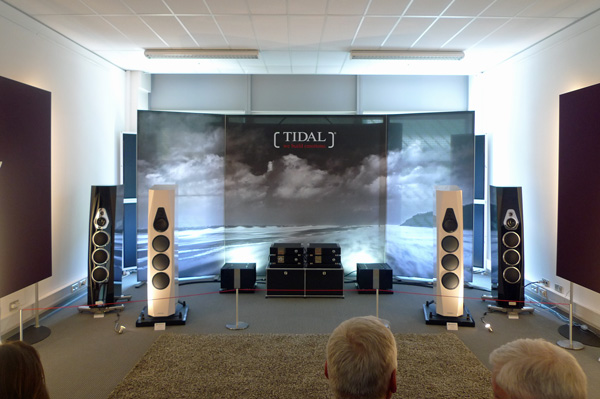
Someone told me that the German audio company Tidal is not pronounced "Tie-dell" but rather "Tee-dahl," which I immediately assumed was to distinguish the audio manufacturer from the streaming service I use every day. Now, if I understood Tidal's US dealer Doug White correctly, Tidal has created its own subsidiary company named Vimberg—whose purpose is to distinguish itself from its parent company by name—while still associating itself with the extreme artisanal manufacturing of its parent company.
Vimberg is making two new three-way floorstanding speakers named Mino and Tonda—the latter of which I auditioned right next to Tidal's similar-looking (but much more expensive) Akira. I have experienced the 180,000 Euros/pair Akira several times and if memory serves me, this new 23,000 Euros/pair Vimberg Tonda sounded damn near as refined and concise as its much more expensive stablemate. (Both speakers are constructed in the same factory.)
The new Vimberg Tonda lacks the Tidal Akira's diamond tweeter and midrange drivers. It also lacks the Akira's four rear-firing bass drivers. Less noticeably, it features a reduction in Tidal's extreme attention to materials, finish, and craftsmanship. However, it is similar to the Akira in size and shape; it uses a thick MDF enclosure, as well as Accuton drivers and Mundorf crossover parts.
I called the Tonda,"Tee-dahl Light" and thought, Wow! This white beauty gives me 80–90% of the fancy speaker's sonics at less than 20% of its cost. What is not to like?
Supporting the Tondas' excellent, Tidal-like presentation were Tidal's own Audio Presencio Reference preamplifier, Audio Ferios Mono amplifiers, Audio Camira DMC (DAC), and last but not least, Tidal's new cables.
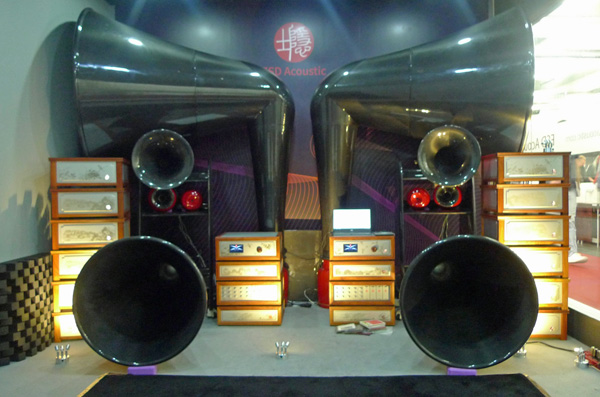
Everywhere I wondered in the MOC I saw big banners declaring the virtues of ESD Acoustic horn speakers. There was always a picture of a pair of big, black, right-angled bass horns projecting from a red farmer's milk can, which I presumed was a giant field-coil driver. After 30 minutes of being lost, I found the little glass-walled room with ESD's l a r g e, black-and-red "Full Horn System."
Many years ago, I tried creating my own-designed full horn system. I used a combination of vintage Altec, Western Electric, and new production TAD drivers. The centerpiece of my experiments was a series of wooden Trackrix midrange horns created by my old friend Bruce Edgar. (They were fitted with WE755 full-range drivers.)
It's been almost 30 years since I've seen Dr. Edgar. I mention Bruce, because Edgar is the "E" in ESD and Bruce is the mind behind the Full Horn's expansion characteristic. Technical Advisor Sam Saye is the "S" and company chairman David Dai is the "D" of ESD Acoustic located in Hangzhou, China.
Auditioning these radical-looking, carbon-fiber horns involved a lot of hand shaking, bowing, smiling, and careful listening. David, Sam, and their crew went to extreme lengths to describe each part of this super sophisticated, super expensive, five-way Full Horn System.
Everything in the system is sold à la carte. The five field-coil compression drivers total $265,000! The carbon-fiber horns cost over $370,000. The electronics shown come in beautiful hardwood-framed cabinets featuring Chinese-style mortise and tenon "leg" joints. The faceplates are decorated with reproductions of classic Chinese art. The electronics add another $200,000 to the system price.
Perhaps you are wondering, how did it all sound?
I listened to a variety of Chinese and European music and . . . I am sorry to say; I had trouble finding much sonic or musical merit. Transients were fast, but seemed disembodied. The system struggled to register accurate tone. Vocals were brittle and sometimes piercing. Frequency response seemed off kilter.
But wait! There is an obvious explanation for what I experienced.
A hornspeaker of this dimension needs the listener to be at least four or five meters from the mouth of the largest horn. Multiple horn drivers need long room dimensions to merge completely. Multiple horn drivers must be positioned precisely. And none of this was possible in the tiny 3m x 4m x 3m glass-walled room.
I really believe these fine smart ESD Acoustic people came to Munich High End with a fresh new design, big hearts, and a lot of hope. I also believe that, in a much bigger room—maybe a palace somewhere?—this system could sing like a beautiful bird.
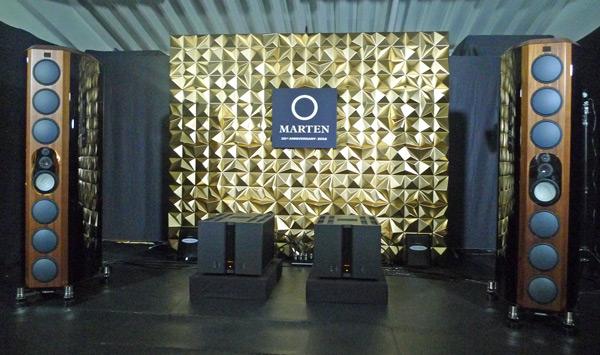
I am standing in the hall, talking to my friend Michael Trei, trying to convince him that the TuneAudio horns I wrote about earlier are better than he thinks, when suddenly Michael Fremer shows up. As I am raving about the Tune horns, Mikey starts raving back about the sound in the Marten loudspeaker room. He says, "Herb, go listen. Tell me what you think. I think it the sound is wonderful . . . It is exactly the type of sound I like. It's me!" I tell him, "That is good to know. Now I am doubly curious. The Marten room was my next stop anyhow." As he was walking away, Mikey turns and asks, "So Herb, what kind of sound do you like?" Nervously, I stuttered, "Ahhhh, I don't know . . . maybe the Harbeth room?"
The Marten room was the most attractive listening environment I'd ever encountered. After my eyes let go of the real gold Golden Crystal diffusors behind the world-premiering Marten Coltrane Memento 2 loudspeakers (310,000 Euros/pair); after my mind stopped staring at the dark monoliths that were the Vitus Audio MP-S201 stereo amplifiers (170,000 Euros/each, and bridged for mono at the show), I noticed something really unusual: the carpeted floor of the entire room had been covered with thick, black, interlocking, rubber panels. Wow, I thought: the Marten Coltranes look rad in this shadowy room of black rubber—and real gold.
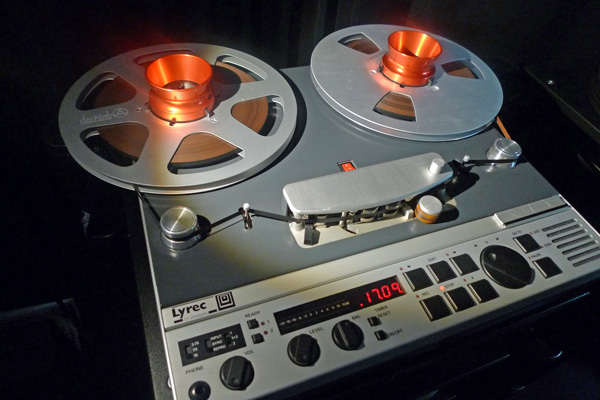
I was flattered when Leif Olofsson, founder and chief designer, of Marten loudspeakers greeted me warmly. It felt nice, and I sat down relaxed and contented. Leif brought me a press kit and proceeded to explicate his latest creation. Then I got up and he gave me a tour of the system, which featured three killer sources: a Lyrec (of Denmark) Frida MkII reel-to-reel tape deck (NP); a MSB Select II DAC with Dual Mono Power Bass (120,000 Euros); and a Thales TTT-Compact II turntable with Thales Statement tonearm and EMT MC cartridge. The phono stage was a Whest Reference 5 MC REF V (14,700 Euros). The line-level pre was a Vitus Audio MP-L-201 (55,000 Euro). Cables were by Statement and Jorma. Power was conditioned by Vibex.
But Fremer said, this was his sound, so I impatiently asked Leif to "please fire it up."
The first piece was the Vox-Turnabout classic, Rachmaninoff's Symphonic Dances, with Donald Johanos conducting the Dallas Symphony Orchestra, on Analogue Productions Ultra Tape. The sound was unquestionably impressive and my first thoughts were the words completely well-sorted. I whispered those words over and over. I know this recording (as an LP) very well and I had never heard sound this smooth quiet and relaxed. I collect Vox-Turnabout LPs and usually they have electrifying dynamics mitigated by a slight subtle tight grainy quality that infects every Turnabout pressing I've ever owned. This tape had none of that. After that Leif played Linda Ronstadt singing "Tracks Of My Tears."
Now I completely understood what Mikey liked. The sound was near impossible to fault. It had good weight and firm body. Transients were a joy to apprehend. Momentum had a well-balanced positivity. Everything moved and danced and was properly described. But I still felt anxious wondering, why was this fantastic-best-sound-at-Munich-type system not engaging me? I worried about my own taste.
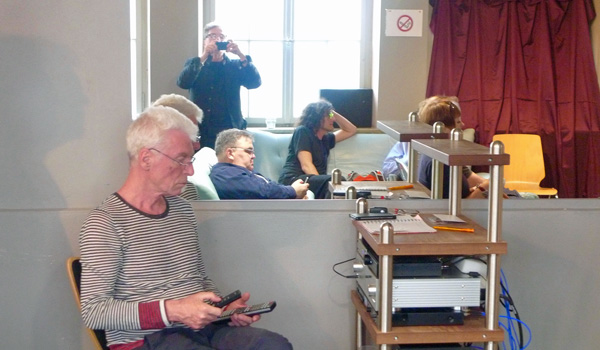
The show closed at 6pm on Saturday. By7 pm they've kicked everybody out of the building and locked the doors. That is when I met Mike Trei, David Chesky, and Joseph Audio's Jeff Joseph on the sidewalk in front of the MOC. We wove ourselves across the street, into a parking lot, round some giant dumpsters, to the back door of something that looked like a factory. Down a wood-paneled hall into a little abandoned office with some leather couches and folding chairs. Chesky introduced us to Heiner Basil Martion (above) and Rikta Annette Schaden—proprietors of Martion Audiosysteme—makers of the legendary Einehorn two-way horn loudspeakers, which cost only 22,000 Euros/pair!
I was tired, so I picked the softest couch. Unfortunately, it was a little too close both to the full-range (200Hz–20kHz) horns and to the corner-horn type bass enclosures and were placed near the room's corners.
Heiner Martion said he'd been building hornspeakers "seit 40 Jahren." He started his demonstration by explaining how ". . . music is pulses with empty spaces in-between." Good sound he said demanded that the empty spaces be " . . . as empty as possible."
Of course, him saying that directed my attention towards the music's empty spaces. Were they as empty as possible? I didn't think so. Heiner played some techno music that was loud fast noisy and fun, but empty spaces were hard to find. What I did notice was an extremely fine musical grain and near-absolute coherence.
The Einhorn's single horn covers everything above 200Hz and is integrated with a powered corner-loaded bass horn module via an active digital DSP crossover that also time aligns the bass and midrange horns. Heiner declared the Einhorn's impulse response to be very good. It seemed to work, because, like I said, this speaker was coherent and dynamic in an extremely beguiling way. Heiner Martion put on some music I didn't like, but by the end of the track—I loved it. Something good was going on.
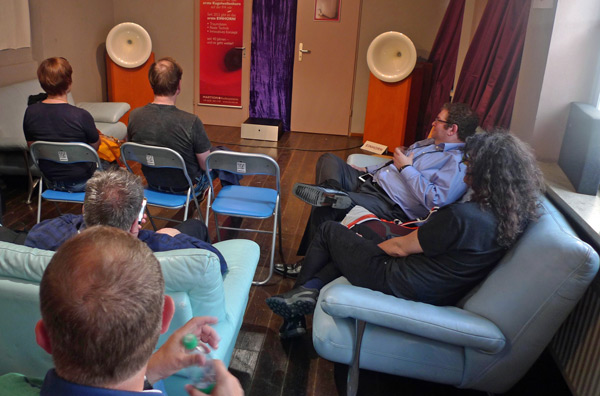
Eventually, I asked to hear a piano concerto. My plan was to see if the Einhorns could rendered it in proper scale. When the concerto started, Chesky and I started giving each other that secret approving look—again. Damn, I thought, the piano sounds so wood metal and felt real. Every musician was alive and individually present.
Then Jeff Joseph directed me to a lone metal chair in the back of the room. On this uncomfortable chair I experienced a high-quality paradigm shift. This was the spot where everything came together. The lens focused and imaging became dead-on. Most importantly, the Einhorns sucked me forcefully into whatever music Heiner was playing. The Einhorns completely dis-engaged my critical thinking. This was exactly the type of sound I like!
That was Saturday night. Sunday I returned to Brooklyn where my Harbeth 30.2 monitors sounded very small—but more coherent than almost anything I heard in Germany.
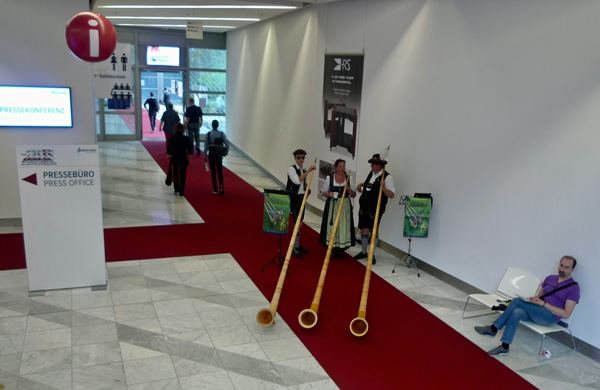

I loved your last paragraph.
I leave shows full of want & lust, then turn on the home system and think, "Hey, this ain't so bad!"
It's great to come home to something that can so quickly sooth the furrowed audiophile brow.
Thank you again for a great show report.
If we could figure out some affordable ways to make horns, we could could also make bank!

For me Show experiences, like this, are like squeezing a Puffy Snow Suit into a half gallon stuff sack : All these talented Creator's work being summarized by a few careful thoughts and then into a few incomplete sentences resulting in one or two critical purchase investments after only a careful few minutes of auditioning.
Shows can be like trying to find a beautiful woman at a beauty Contest. Here, where Audio gear is the Art-form, Europeans are gifted Masters.
Tony in Michigan
ps. PS Audio's best stuff is at cheap prices compared to Munich gear. Maybe Munich is a Show for top 1%ers.

lovely stuff
Tony in Michigan
ps. I like it better than Thompson's, it's smooth, creamy and kind-of sweet!, without being spiced with sharp edged facts. Can we have more?

describes both the experience of listening and feeling and emotion of the music AND the essential technology behind those sounds better than anyone.

One of your best show reports, Herb. It was both personal, and also brought me there.

Glad you found your way to Martion! I have one of the few pairs of his Bullfrog speaker in the US and would love the opportunity to hear the Einhorn one day. The bullfrogs have brought me closer to the music than any speaker I've ever experienced.